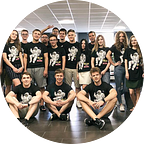As always, business strives to reach as large an audience as possible. In our digital era, every device is a channel of interaction between business and client. Since there are so many types of devices, businesses have to develop and maintain a whole host of client-server applications. Each application requires personalized content that needs to be managed. This situation led to the birth of content management systems (CMS) and a headless CMS in particular.
What is a content management system?
A CMS in general is an information system or a piece of software used to support and organize the collaborative process of creating, editing, and managing content.
A headless CMS is a content management system that separates the data layer from the display layer. Using this system, you can manage the content of any clients in the client-server architecture: a website, a mobile application, or an Internet of Things (IoT) device. The system allows you to manage all platforms from a single interface and flexibly personalize content for each of them by centralizing and distributing content in a universal format.
Why you need the headless CMS
The headless CMS is only responsible for managing “clean” content. All of the content is published using the headless CMS and made available to any app via the API. This architecture is rapidly gaining popularity. It gives developers a lot of space for creativity and allows owners to manage content, update the design, expand functionality, and change the app’s logic.
The main value of the headless CMS is the ability to work on content for different platforms in the same interface. Content for any platform, including a site, mobile applications, and IoT is distributed in a universal format, which gives developers the freedom to choose technologies and eases management for owners.
Moreover, the headless CMS is secure. It can be hidden architecturally so that the client in the client-server application cannot access it directly. Therefore, it’s almost impossible to attack the system from the outside.
Headless CMS is suitable if you want to create:
- Single-Page Applications (SPA): React, Angular
- Dynamic applications: JavaScript, HTML, CSS
- Applications for IoT
- Mobile applications: Android, iOS
Headless CMS vs Traditional CMS
Unlike a traditional CMS, in the headless architecture, the client-server application is not associated with custom CMS code. This makes it possible to migrate from one headless CMS to another with minimal costs.
The main difference between a headless CMS and a traditional one is that you don’t have to be a programmer to use a traditional CMS. For example, WordPress can be tailored with very minimal programming knowledge, or by using tutorials on YouTube, since there is no need to write code.
However, in the headless CMS, in order to even begin working, you need to write code and create a content model (especially, in the case of Contentful).
For example, we have the “blog post” content model, which consists of the title, publication date, author of the post, text, text preview, and so on. Each of these values will have its own field in Contentful, representing a kind of table.
The task of the code in this case is to enable the client to perceive the submitted model visually. For example, you can use code to specify what font the title should be written in and where it should be located. All of these features are provided in order to create the most logical and understandable work for developers and high-quality content for users of the site or application.
A list of headless CMS to consider
Along with Contentful, which we have already mentioned, there are many other headless CMS, such as:
- ButterCMS (Butter CMS provides a WYSIWYG interface to support the production of SEO landing pages, customer case studies, company news pages, and more)
- Contentstack (Contentstack is a headless CMS that provides RESTful APIs. Features include content previews, collaboration, asset management, workflow management, and versioning)
- dotCMS (Their Java CMS features multi-lingual and multi-tenant capabilities, along with a WYSIWYG editor alongside drag-and-drop features that enable marketers to engage in content modeling, workflow building, and page layout modification)
- Mura CMS (Developers can benefit from APIs, Docker support, CSS framework support, as well as support for popular JavaScript frameworks like Vue.js, React.js., and Ember.js)
- Cockpit (Cockpit describes itself as a “content provider” and “not a website builder”, meaning that it’s a back-end only solution that stores and distributes content)
Conclusion
Today, a site can easily be created both by a person who knows programming languages and by a person who has never personally dealt with codes.
However, it’s still advantageous to be able to write code and work on the site in depth. Of course, choosing a headless CMS is not the easiest way, but the number of advantages that it provides in return for the work you do fully justifies it.
There is no doubt that once you have worked with a headless CMS, you will love it. All you have to do is select the CMS platform you need.
Originally published at https://yellow.systems.
